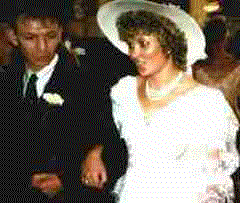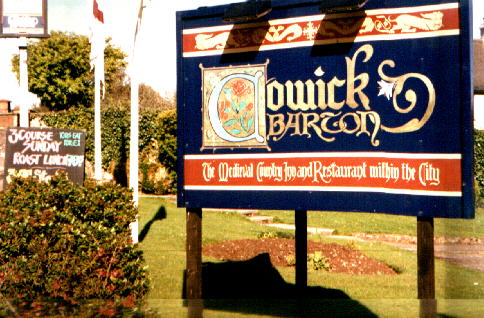
|

|
| Use the text links for more information! |
| Fireman and the Saint
Opposite this pub are some red brick community buildings.
St Thomas had its own fire brigade from July 1889 and this was where the
brigade was housed until they became redundant 2 years later when St Thomas
joined the Exeter Municipal Area and the brigade joined the Exeter Fire Brigade.
The buildings have also in the past
been used as a library and printing works. Next to the old Fire Station was Beaufort School for
Girls and young Gentlemen.
A little further on is the entrance to St Thomas Park.
In 1887, the year of Queen Victoria's jubilee it was decided to provide a safe area for children to
play. In March 1891, the park was opened. Of the 4 acres, 1 acres was reserved for adults to use on
Saturdays, with the other 3 for the kids. |
The bridge linking Exeter and St Thomas is an awful lot shorter
than the mediaeval version of 700 feet and 18 arches. A church was
built on this side of the river on that bridge around 1257, this was the
church that was eventually washed away in 1403. Parishioners wanted another
church built and asked the Prior of Cowick Monastery to build another church
on safer land. This building was consecrated in 1412 by the Bishop of Stafford
and was dedicated to St. Thomas a' Becket,
the one who defied Henry II
and was slain in Canterbury Cathedral.
The Prayer Book Rebellion of 1549 saw the St. Thomas priest Vicar Robert Walsh laying siege to Exeter from St. Thomas in the west and St. Sidwells in the east as a member of the catholic rebels. Welsh persuaded the rebel leaders not to burn the city, because many of its citizens preferred the Latin Mass. |
 |
Tactical Errors
However a tactical error was made when a Kings Army messenger
was captured and hanged on Exe Island.
The rebels were eventually defeated by Lord Russell at Clyst St Mary and
Welsh was hanged in Catholic vestments from the church tower. After this,
the church was dedicated to St Thomas the apostle. The original tower fell
to the ground when the church was destroyed by fire in 1645, this was possibly connected to the
Civil War (though there is no evidence).
General Thomas Fairfax, who was head of Cromwell's New Model Army was
holed up in Alphington a year later. This present building was built in
its place.
Services are well attended and many weddings take place on Saturdays
when unfortunate young men are sentenced to a life of none stop shopping
and decorating. A tactical error was made on 2nd June 1990. The short but
often overlooked phrase, 'I do' does mean 'Life'. The
word 'obey' does not appear in the post marriage version of her dictionary along
with a few other words that were perfectly acceptable before. |
|
The church hall is called Buller Hall after Major General Rt Hon
Sir Redvers Buller,
who commanded the British forces in South Africa at
the start of the Boer War. He died in 1901 and the hall was built in 1915
in his memory. Two coats of arms can be seen, those of Becket and those
of Buller. It underwent severe renovation with the frontal facade being kept in 2002 / 2003,
after being sold by the Church for conversion into flats for the elderly.
The vicarage was built in 1800-05, when it replaced an original vicarage which used to stand on the corner of Old Vicarage Road. |
|
|
|
|
Just a little further along Cowick Street is the First and Last
which used to be known as The Falmouth Inn. It was rebuilt in 1913 and re-named in the
early 1980's to reflect the fact that the first and last trams left here for central Exeter (1905-1931).
Until 1884 a gate and tollhouse had stood at this point.
You'll have noticed the row of very old cottages on the way. These were described by John Stocker in the 1860's. "Cowick Street had houses on each side, and any number of courts, and a great many houses were thatched. The kitchens were floored with pebbles.... Nearly all the houses had tiny gardens and nearly every cottager kept pigs; Reed's Court contained 20 houses and about 100 pigs. The last thatched house in Cowick Street was the Falmouth Inn."  Bowhill House is just about 150 metres up Dunsford Hill, you may wish to take a look. In Stocker's time, Dunsford Hill was open fields and meadow. Bowhill Mental Hopital was once also a feature of this area. |
 |
 |
|
The plaster plaque over the fireplace shows the arms of the Baron
family and the date 1657. The Barons are mentioned in the parish records
from 1603 until the 1660's and it is possible that they bought the Cowick
Barton from the Russels after being tenants. The Barons were wool
merchants and leading members of Exeter's Company of Weavers and Tuckers which met
at Tuckers Hall in Fore Street. This hall
is open to the public and is and displays an excellent example of a medieval roof and
17th century oak panelling.
The Cowick Barton was aquired by Courage Brewery in 1963 who opened it up as a pub, Husseys had previously sold the building in 1920. |
|
|
|